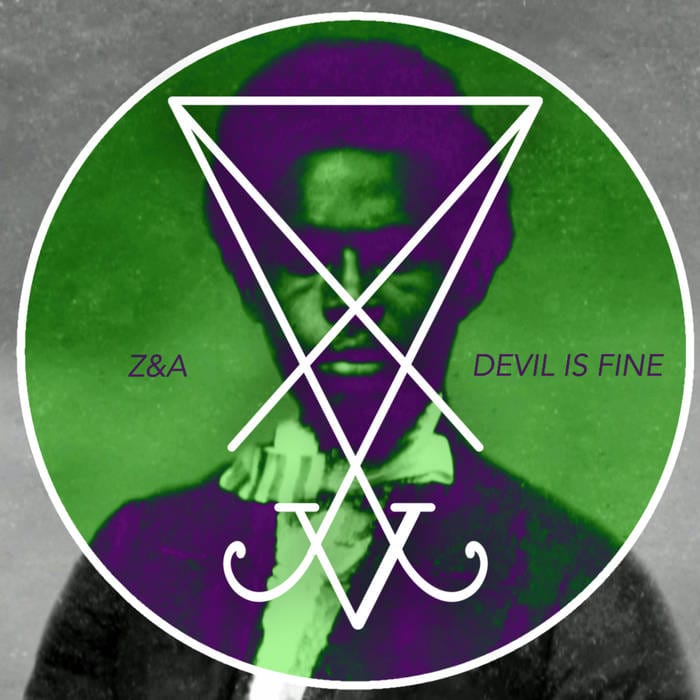Uncompromising. There is hardly another attribute that is used more inflationarily in music journalism—and is so rarely applicable. Zeal & Ardor shows what musical uncompromising actually sounds like. The project is the brainchild of Swiss-American dual national Manuel Gagneux.
The story of how Zeal & Ardor came about is already an urban legend: it all started on the most abysmal of all internet forums—4chan—where Gagneux was looking for new inspiration. He asked users to name some music genres, and within 30 minutes, he had produced a song out of them.
The terms «black metal» and «ni**er music» were mentioned. The first reaction of Gagneux, who is black himself, was outrage and rejection. But the idea would not let him go.
And so the album Devil Is Fine was created, with the first version released on Bandcamp in April 2016. It is a unique fusion of slave spirituals and the occult sounds of black metal. Metal journalist Kim Kelly and her extensive network then triggered unprecedented hype around Zeal & Ardor. No other Swiss music project has ever caused such an international sensation. From «Rolling Stone» to «SRF» and «Wochenzeitung» to «Die Zeit»–they all wrGagneux’s Gagneux's creation: «Black Black Metal.»
The Beginning
When you listen to the album for the first time, it is immediately clear where the overwhelming enthusiasm comes from. In an age when music has become an ever-present commodity when styles converge instead of contrasting and inevitably becoming boring, Devil Is Fine is like a punch in the face. There is nothing to compare the sound with. It is unique.
The eponymous track Devil Is Fine is an amazingly gentle introduction to the album. The spiritual vocals begin naked in an empty space, and the arrangement builds up hesitantly and subtly. The guitars skilfully stay in the background, lying in wait. They will ambush the listener soon enough. The instrumental part grows larger, louder and more powerful. But just before the approaching climax, the construct breaks apart again, leaving only single piano strokes.
The Trap
The entry with Devil Is Fine remains devious. It lures several groups into a trap: the metal fans who hoped that Zeal & Ardor would finally bring movement into conservative black metal and the brave who want to get to the bottom of the hype surrounding the project. They will now think that the black metal is not as bad as they thought.
But then along comes In Ashes. Without warning, the guitars vibrate brutally, opening a black maw that sucks everything into itself. Over this rumbling storm, the voice howls: «Burn the young boy, burn him good.»
At the latest now, you know again what uncompromising means. In Ashes is so bulky, so consistent in its concept and merciless in its execution that the overwhelming demands leave you disarmed.
Sacrilegium I is the first of three interludes. They are all further proof that Zeal & Ardor simply cannot be defined. Sacrilegium I is a stuttering electronic piece, neither spiritual nor black metal, but most closely related to dubstep. As confusing as it may sound, it sounds more familiar than the first two songs and is, therefore, a well-calculated breather.
With Come On Down, the band is already adding to it again in the «black black metal» manner. The song probably comes closest to traditional metal. Come On Down is the perfect symbiosis of slave spirituals and heavy guitar thunderstorms. As if Devil Is Fine and In Ashes had paired up during Sacrilegium I.
Those who thought that Come On Down was already the perfection of the idea will Children’s Summon like an ignorant child. The lyrical theme of Come On Down is taken further. The sacred chants cut into the breathless metal like ominous spells, brazenly sawing through the unstoppable speed.
Sacrilegium II brings the break again. A lovely bell melody sounds – yes, maybe even a lullaby. A valium for the ear canal. But as much as you wish this interlude had a calming effect, there is still unease as Sacrilegium II drifts into a psychedelic reverberation.
The Climax
While In Ashes, Come On Down, and Children’s Summon were still dominated by black metal, the tables are turned once and for all in Blood in the River. Here, the spiritual with an apocalyptic message dominates:
A good god
is a dead one
A good god
Is the one that brings the fire
A good lord
is a dark one
A good lord
Is the one that brings the fire
The riverbed will run red with the blood of the saints and the blood of the holy
It is the ultimate highlight of the album. The magnificence of the concept behind Zeal & Ardor is manifested in no other track as succinctly as in Blood in the River.
The Irritation
Then comes another irritation: What Is a Killer Like You Gonna Do Here is neither spiritual nor black metal. It is a murmuring, dark country number. There is something of Nick Cave about it, along with the weird guitar interlude. But the song is neither particularly unique nor particularly good. And it is quickly forgotten.
The question marks that can be erased from the three Sacrilegiums in a generous act must be underlined for this song. Provocation as a side effect is a nice thing—especially when it hits black metal purists.
But What Is a Killer Like You Gonna Do Here remains the only real foreign body on the album. One that could have been confidently left out. That Devil Is Fine is no typical metal album has long been apparent.
So you are almost relieved when the conclusion of Sacrilegium III finally concludes the album. A melody that is reminiscent of classical music but, in its execution, is reminiscent of the MIDI sound of early console games. A conciliatory farewell.
The Scheme
It is striking that the songs of Zeal & Ardor seem to be structured similarly. In an interview with the online magazine alpkvlt.ch, Gagneux explained the scheme:
It is no coincidence that I usually start with a group sing-along. This singing, which was intoned by the slaves together to motivate each other at work, has a driving force. It inevitably has a welcoming effect and creates a sense of community. Now, metal can also have this driving force; but it can also come across as aggressive and unwelcoming, depending on the subjective attitude of the listener. That is why I wait a while before I let the metal guitars in. By that point, you've already been gripped by that sense of community. At that point, the metal guitars come across as a tailwind.
The impulse
If we leave out What Is a Killer Like You Gonna Do Here, then Devil Is Fine is by far the most fascinating album Switzerland and the world have heard in recent years. No wonder, then, that the coverage is increasingly penetrating into spheres that otherwise dismiss metal in general and black metal in particular as noise or a satanic subculture.
This also leads to raised eyebrows—not least among metal fans themselves. But Gagneux does not care much about that:
I am well aware that the concept can be problematic for some people. Be it right-wingers who don't like to see black metal mixed with black music, or left-wingers who break what I do, a cultural theft or sacrilege. My aim is to break down barriers.
And yet, this is precisely what Zeal & Ardor have arguably done best. Manuel Gagneux, who is actually a pop musician, is shaking up the metal genre, which has been stuck in a rut for years. Devil Is Fine is not only a breath of fresh air for metal in terms of musical experimentation but also in terms of its external view of metal itself.
The album has the potential to become the blueprint for a whole new generation of metal bands. A generation that doesn't care much for unwritten rules but instead embraces metal for what it is: an incredibly diverse base material. This meant nothing less than a return to the origins of the genre. Only by doing so could metal develop into a style that could produce such a vast number of subgenres.
The Sequel
What began as a provocation on the internet has now become a provocation cast in music in the form of Devil Is Fine. Gagneux could now leave the Zeal & Ardor project alone, but work continues because he is still not satisfied with his sound. Just a few days ago, a new song emerged: Don't You Dare was played in a live session on RTS Couleur3.

Zeal & Ardor – Devil Is Fine
Release: 24/02/2017
- Devil Is Fine
- In Ashes
- Sacrilgium I
- Come on Down
- Children's Summon
- Sacrilegium II
- Blood in the River
- What Is a Killer Like You Gonna Do Here?
- Sacrilegium III





